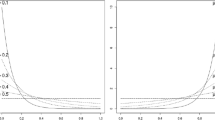Summary
The Burr distribution, having two shape parameters in addition to the usual parameters for location and dispersion, is very flexible and has several interesting and often used special forms. A formal statement of the approximate minimum chisquare is made and then developed for the Burr.
Bias and variance functions are derived for F−1 (p). Finally, the approximate normal and six of its limit forms are also given as a prelude to a more general approach bx employing a family of response functions when analyzing ordered quantal response (binary) data.
Similar content being viewed by others
References
Berkson, J.: “Application of the Logistric Function to Bio-Assay.” Journal of the American Statistical Association39, 357–64, 1944.
Bertalanffy, L. Von: “Quantitative laws metabolism and growth.” The Quarterly Review of Biology,32, 217–31, 1957.
Bratcher, T. L.: “Bayesian analysis of a dose-response experiment with serial sacrificies.” Journal of Environmental Pathology and Toxicology,1, 237–92, 1977.
Burr, I. W.: “Cumulative Frequency Functions.” Annals of Mathematical Statistics,13, 215–32, 1942.
Burr, I. W.: “A Useful Approximation to the Normal Distribution Function, with Application to Simulation.” Technometrics,9, 647–51, 1967.
Burr, I. W.: “Parameters for a general system of distributions to match a grid of α3 and α4.” Communications in Statistics,2 (1), 1–23, 1973.
Burr, I. W. and P. J. Cislak: “On a General System of Distributions-I. Its Curve Shape Characteristics. II. The Sample Median.” The Journal of the American Statistical Association,63, 627–35, 1968.
DeGroot, M. H.: Probability and Statistics. Reading, MA: Addison-Wesley Publishing Company, 1975.
Ferguson, T. S.: Mathematical Statistics a Decision Theoretic Approach. New York: Academic Press, 1967.
Moore, R. H. and R. K. Zeigler: “The Use of Non-Linear Regression Methods for Analyzing Sensitivity and Quantal Response Data.” Biometrics,23, 563, 1967.
Prentice, R. L.: “A log gamma model and its maximum likelihood estimation.” Biometrika,61, 545–57, 1974.
“Discrimination among some parametric models.” Biometrika,62, 607–14, 1975.
“A generalization of the probit and logit methods for dose response curves.” Biometrics,32, 761–68, 1976.
Richards, F. J.: “A flexible growth function for empirical use.” Journal of Experimental Botany,10, 290–300, 1959.
Seibert, G. B.: Estimation and confidence intervals for quantal response or sensitivity data. Tech. Report 66, Department of Statistics, Southern Methodist University, Dallas, TX 75275, 1970.
Turner, M. E., Jr.: “Some classes of hit theory models.” Mathematical Biosciences,23, 219–35, 1975.
Turner, M. E., Jr.; E. L. Bradley, Jr.; K. A. Kirk and K. M. Pruitt: “A theory of growth.” Mathematical Biosciences,29, 367–73, 1976.
Turner, M. E., Jr. and K. M. Pruitt: “A common basis for survival, growth and autocatalysis.” Mathematical Biosciences, in press, 1978.
Rights and permissions
About this article
Cite this article
Drane, J.W., Owen, D.B. & Seibert, G.B. The burr distribution and quantal responses. Statistische Hefte 19, 204–210 (1978). https://doi.org/10.1007/BF02932803
Issue Date:
DOI: https://doi.org/10.1007/BF02932803




